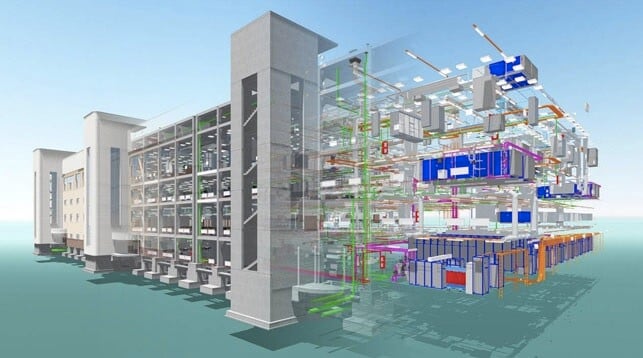What is BIM in Civil Engineering and Why Do Civil Engineers Love BIM?

Table of Contents
Building Information Modeling (BIM) has revolutionised civil engineering by offering an intelligent platform that integrates all project aspects into a virtual model. This BIM model is like the digital clone of the actual structure, but it's so much more than just a 3D model! In this blog, we will explore the reasons why BIM has become a beloved tool for civil engineers, revolutionising the way they approach and overcome complex tasks with ease.
What is BIM in Civil Engineering?

So, what does BIM stand for in civil engineering? BIM, in civil engineering, refers to the implementation of digital tools and softwares to create a comprehensive 3D model that represents the various elements of a construction project. It integrates a project’s architectural, structural, and MEP (Mechanical, Electrical, Plumbing) aspects, enabling real-time collaboration and information exchange among all parties involved in the project.
Imagine this: instead of dealing with separate drawings and documents, BIM integrates everything into one intelligent system. The model contains not only the visual aspects of the project but also finer details like materials, costs, schedules, and even maintenance requirements.
Here, the BIM model helps civil engineers troubleshoot a project beforehand in this virtual world, thereby reducing errors, saving time, and enhancing overall project quality.
Also Read : https://www.novatr.com/blog/bim-in-civil-engineering
Why do Civil Engineers Love BIM?
BIM for civil engineers has become an industry favorite and it's not hard to see why! Consider the construction of a new bridge as an example. With BIM, civil engineers can create a detailed 3D model of the bridge, simulating its behavior under different conditions. This allows them to detect potential clashes or design flaws early on in the pre-construction stage, preventing costly rework during construction.
During the design phase of a project, civil engineers can simply leave no room for errors or miscalculations. Enter BIM for civil engineers- this nifty technology reduces the odds of errors and grants civil engineers peace of mind throughout the project's lifecycle.
Moreover, civil engineers love BIM for its power to break down communication barriers. With BIM, gone are the days of siloed work; BIM enables professionals to collaborate efficiently throughout the project lifecycle.
Even after a project’s completion, the BIM model doesn't just gather dust. It becomes an invaluable asset for civil engineers aiding in project management, facilitating maintenance tasks and even assisting in future expansion plans.
With BIM in their toolkit, civil engineers confidently stride towards delivering projects that are on time, on budget, and of exceptional quality. Hence, BIM for civil and structural engineers, becomes an indispensable tool.

Benefits of BIM for Civil Engineers
BIM has revolutionised the field of civil engineering by delivering fewer mistakes, streamlined processes, and increased savings. Through enhanced collaboration and data-driven insights, BIM is more than a technology – it's a game-changer for civil engineers. So, you're not just making decisions smarter, but you're also avoiding expensive mess-ups. As a civil engineer, getting the hang of BIM means you're on track for smoother teamwork and more successful projects. Read further to understand what is BIM in civil engineering and why BIM for civil engineers is extremely useful.
1. Visualisation
BIM enables civil engineers to visualise construction projects through 3D models, rendering, clash detection, simulations, and time-based and cost-based visualisation. It improves communication, design validation, and decision-making, leading to efficient outcomes.
2. Data Integration
BIM integrates diverse data sets, including geometric information, materials, costs, scheduling, and project documentation. BIM allows civil engineers to incorporate data sources like reality capture data, 2D CAD, raster data, and GIS information. This centralised data management ensures consistency and reduces the risk of errors. This also fosters collaboration among different stakeholders, such as architects, structural engineers, MEP engineers, and contractors.
3. Informed Project Decisions
BIM helps in construction planning by providing a detailed construction sequence, visualising the construction process, and improving resource allocation. BIM tools provide insights into sight distance, flood simulation, clash detection, dynamic site analysis, and many more parameters. It enables civil engineers to make smarter decisions throughout the project lifecycle.
4. Control Cost
BIM models help in calculating accurate quantity take-offs, helping civil engineers estimate the exact materials and quantities required for the project. This helps civil engineers to prioritise project investments and shifts the focus to project value rather than just control cost.
5. Regulatory Compliance
The use of BIM for civil engineers extends to legal compliance too. BIM helps in regulating compliance with local building codes and regulations. This helps civil engineers design structures that meet all legal requirements.
Adoption of BIM in Civil Engineering

According to a recent report by Dodge Data & Analytics, the biggest and most aggressive movers to BIM are civil engineers. The report states that almost 70% of civil engineers have adopted BIM since 2016.
The use of BIM for civil engineers goes beyond its traditional applications. BIM brings to the table modern applications like digital twin technology, which allows engineers to create virtual replicas of physical assets. Governments, public agencies, and private companies have been encouraging and in fact, mandating the use of BIM on their projects.
Furthermore, the inclusion of 4D and 5D BIM enhances project planning and control. By incorporating time (4D) and cost (5D) dimensions into the BIM model, engineers can visualise the construction sequence, track progress, and optimise schedules and resource allocation. By leveraging BIM's power alongside AI and GIS integration, civil engineers can also efficiently manage infrastructure assets.
Other modern applications of BIM in civil engineering include AR/VR integration, prefabrication, and sustainable design.
Career Growth of Civil Engineers with BIM

Civil engineers with BIM expertise bring several distinguishing factors to their careers compared to regular civil engineers. What sets civil engineers with BIM skills apart from their regular counterparts is their ability to visualise and analyse projects in a 3D environment, facilitating better design decision-making in the process.
Additional skills in data integration, project management, and lifecycle analysis make them valuable assets in an era of smart cities and sustainable infrastructure development.
The current demand for BIM-savvy civil engineers is rapidly increasing as governments and private organisations worldwide mandate the use of BIM. This trend opens up numerous opportunities for them to work on complex and large-scale ventures, allowing them to tackle intricate designs and construction challenges more effectively with the aid of BIM.
In the near future, BIM professionals may find themselves leading implementation teams, taking on managerial roles, and playing significant roles in shaping the future of construction practices.
Job profiles for civil engineers with BIM skills include BIM coordinators, BIM Technician, BIM modellers, BIM managers, and VDC (Virtual Design and Construction) specialists. These professionals work closely with architects, contractors, and other stakeholders, using BIM software to create and manage intelligent 3D models of construction projects.
Also Read: https://www.novatr.com/blog/bim-salaries-worldwide
How do you Learn BIM as a Civil Engineer?

The benefits of mastering BIM for civil engineers are numerous, making it a compelling skill to acquire. By becoming skilled in BIM, you acquire the capacity to enhance collaboration among project teams, leading to smoother communication and fewer mistakes. To understand what is BIM in civil engineering, here are the essential steps you can take –
1. Online Courses and Tutorials
Many online platforms offer BIM courses for civil engineers teaching BIM and related software. Platforms like Novatr, Coursera, LinkedIn Learning, Udemy, and Autodesk University provide a wide range of courses suitable for beginners to advanced learners.
2. Certifications
Consider obtaining certifications in BIM software from reputable organisations like Autodesk. Certifications have the power to enhance your credibility and demonstrate your expertise to potential employers.
3. Practical Experience
Practical hands-on experience is a must to polish your skills as a BIM professional. Work on personal projects to develop a portfolio. Seek internships and entry-level positions where you can apply your skills in real-world scenarios.
Also Read: A Civil Engineer's Successful Journey to BIM
Essential Software for Aspiring BIM Professional Civil Engineers

To become proficient in BIM, you need to gain expertise in relevant software tools. Some of the most in-demand BIM software programs include –
1. Autodesk Revit
- Revit is one of the most important BIM software. Widely used for comprehensive building design, covering architecture, structure, and MEP aspects.
- Facilitates collaboration and real-time data exchange.
2. Autodesk Navisworks
- Key for project review, coordination, and clash detection. Integrates models from different platforms to identify conflicts early.
3. Trimble Tekla Structures
- Specialises in detailed structural design and detailing, particularly for complex steel, concrete, and timber structures. Learn Tekla Structures Today!
4. Bentley MicroStation
- Focused on infrastructure projects, offering BIM capabilities for multidisciplinary collaboration and 3D modelling.
5. Graphisoft Archicad
- Primarily for architectural design and collaboration with architects, with user-friendly tools for detailed models and design visualisation.
Also Read - 7 Top BIM VDC Softwares To Learn in 2025
In Conclusion
Having a BIM model for a project is like having a tool to ensure that your project runs smoothly. It's no wonder BIM has become so popular in the civil engineering industry, opening up exciting opportunities for those who master it. As BIM keeps evolving, it'll keep making construction smarter and more sustainable.So, if you're a civil engineer, embrace BIM. It is a no-brainer for a successful and fulfilling career in the field.
If you're curious about taking your BIM skills to the next level, exploring courses like the one offered by Novatr could be a positive step for your career. Take a look at our BIM Professional Course for Civil Engineers course and see how it aligns with your professional aspirations.
For more information on BIM and related topics, head to our Resources page.-1.png?width=767&height=168&name=BIM-C%20A%20(Course%20Banner)-1.png)

 Thanks for connecting!
Thanks for connecting!
-1.png)
.png)







